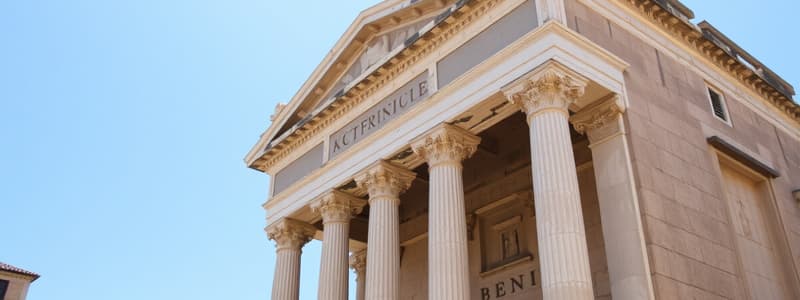Podcast
Questions and Answers
What is the chief mineral wealth of Greece?
What is the chief mineral wealth of Greece?
- Sandstone
- Marble (correct)
- Granite
- Gold
The mountainous nature of Greece contributed to rivalry among its inhabitants.
The mountainous nature of Greece contributed to rivalry among its inhabitants.
True (A)
Which architectural period is known for simplicity and harmony?
Which architectural period is known for simplicity and harmony?
Greek or Hellenic Period
What features were essential in Greek architecture?
What features were essential in Greek architecture?
The principal building type in Aegean architecture is called a ______.
The principal building type in Aegean architecture is called a ______.
What was a common outdoor activity in ancient Greece?
What was a common outdoor activity in ancient Greece?
Match the following influences with their descriptions:
Match the following influences with their descriptions:
Which materials were Greece rich in besides marble?
Which materials were Greece rich in besides marble?
What is entasis in Greek architecture?
What is entasis in Greek architecture?
Flashcards are hidden until you start studying
Study Notes
Historical Timeline of Architecture
- Architecture evolved through distinct periods: Pre-Historic, Greek, Roman, Byzantine, Early Christian, Romanesque, Gothic, Renaissance, and Modern.
- Egyptian and Near Eastern influences were critical in the development of architectural styles.
Greek: Geographical Influence
- Surrounded by sea on three sides, Greece had numerous natural harbors advantageous for trade.
- The mountainous terrain divided inhabitants into rival clans, impacting communication and culture.
- The geography led to the development of islands that hindered easy communication among communities.
Greek: Geological Influence
- Marble served as the primary building material, known for its purity of line and detailed craftsmanship.
- Greece was rich in various metals, including silver, copper, and iron, enhancing its architectural potential.
Greek: Climatic Influence
- The climate promoted an outdoor lifestyle, with many public and religious ceremonies occurring in open air.
- Colonnades and porticoes were prominent architectural features, accommodating the hot sun and sudden rain.
Greek: Religious Influence
- Early Aegeans worshipped nature, with priestesses performing rites.
- Greeks created large statues to honor deities, worshiping natural phenomena, ancestors, and deified heroes.
Greek: Social & Political Influence
- Popular activities included music, dancing, wrestling, and gymnastics, often linked to religious beliefs.
- National games and festivals fostered unity and appreciation for the fine arts, enhancing cultural identity.
- Open-air life shaped public ceremonies and governance, with system variations including tyranny, aristocracy, and democracy.
Greek: Historical Influence
- Early developments included Aegeans, Minoans, and Myceneans (3000 BC – 700 BC).
- The Hellenic Period marked the peak of Greek cultural influence encompassing arts, literature, architecture, and philosophy.
Greek: Architectural Character
- Aegean architecture displayed roughness and massiveness.
- Hellenic architecture emphasized simplicity, harmony, purity of lines, perfect proportions, and refined details, often referred to as "carpentry in marble."
Greek: Architectural Features (Aegean Period)
- Characterized by low or flat roofs and the development of stairways for vertical movement.
- Key building types included "Megaron" houses and palaces.
- Walling techniques included Cyclopean, Polygonal, Rectangular, and Inclined blocks.
Greek: Architectural Features (Hellenic Period)
- Featured rectangular planning and propylaea as temple gateways.
- Temples encircled by colonnades; lacked ceilings but utilized lacquered timber coffer designs.
- Walls constructed from stone, decorated with marble sculptures and mural paintings.
- Entasis used to create optical illusions, correcting the visual perception of sagging or dropping lines.
Studying That Suits You
Use AI to generate personalized quizzes and flashcards to suit your learning preferences.




